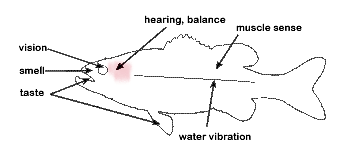Largemouth Bass can be attracted to different colors and can sense vibrations in the water that will bring them to the edge of a lake to lie waiting in the weeds, ready to strike, what could be their next dinner. Are Largemouth Bass Attracted to Sound?
Largemouth Bass have 2 sensors for investigating acoustical disturbances. One in its inner ear & another in the lateral line on its body. Both work off each other to hear & feel vibrations. Despite a Bass’s lack of hearing high frequencies, its curious nature attracts it to all & any kind of sound.
The senses of smell and hearing are important weapons to let the fish know that food is around. Once a Largemouth Bass is alerted to the potential food, it can get closer to investigate and uses its taste or smell to decide whether to eat it or not.
Are Largemouth Bass Attracted to Sound
Largemouth bass are primarily attracted to vibration rather than sound. While they do have a lateral line system that allows them to detect movements and vibrations in the water, their hearing abilities are not as developed as those of some other fish species.
However, they can still sense vibrations created by sound, such as a loud noise or the vibrations caused by a lure hitting the water’s surface. Some anglers believe that certain sounds, like rattling lures or clicking noises, can attract bass by mimicking the sounds of prey. So while sound itself might not be the main attractant, the vibrations it produces could potentially catch the attention of a curious bass.
Can Fish Hear Sound
Fish can perceive sound through their lateral line system, which detects vibrations and pressure changes in the water. While they don’t have ears like humans, some fish species have specialized hearing organs such as otoliths, which help them sense sound waves.
Fish can hear a range of frequencies, particularly low-frequency sounds, which are important for detecting prey movements and avoiding predators. Their ability to hear varies between species, with some being more sensitive to certain frequencies or types of sounds than others. Overall, while fish may not hear in the same way as mammals, they are still capable of perceiving and responding to sound stimuli in their underwater environment.
Fish can hear but have no ear openings on the outside of their bodies. They have heard parts that are located in their heads that can pick up sound vibrations. Also, a fish can sense movement in the water with the Lateral Lines that run down each side of its body. Sharks, which are fish, also have keen abilities. that can pick up disturbances in the water from far away. Depending on the species of fish, they may have a number of acoustical adaptations. These adaptations all depend on the Fish’s habitat.
People hear by detecting sound vibrations. Our ears and brain translate vibrations into sounds and language. Fish hear, but their “ears” are on the inside. Bony fishes detect vibrations through their “earstones” called otoliths. Both people and fish use parts of their ears to help them with balance. 
Being solitary, predators or prey, nocturnal or diurnal, shallow or deep, near the shore or deep in the ocean, migratory or sedentary fish are equipped over time for survival through evolution. Regardless of the complex reasons they can most scientists agree that fish can hear a sound. Some fish make sounds that humans can hear out of water or other fish can hear underwater. Some of these sounds, predatory fish use to hunt them down and eat them.
Some fish have what’s called a Swim Bladder that keeps the fish buoyant in water and also acts as an acoustical impedance differential in the body that can serve as a pressure gradient sensor.
If something falls in the water and makes a splash near the shoreline the Lateral Line will detect the vibration that is made by the disturbance. In some fishes the swim bladder ties into the inner ‘ears’ of the fish by way of a set of bones similar to our own middle ear bones. When the Swim Bladder fills with air it will vibrate across the muscle producing a low-pitch drumming. This can happen as fast as 200 times per second or faster than a Humminbird flaps its wings.
How Do Fish Hear
Fish typically don’t possess ears like humans do, but they can sense vibrations and pressure changes in the water using a system called the lateral line. This system consists of sensory cells located along the sides of the fish’s body, which can detect changes in water movement caused by nearby objects or disturbances. Additionally, some fish species have specialized hearing organs, such as otoliths, which are tiny structures in the inner ear that help them perceive sound waves.
These adaptations allow fish to detect sounds and vibrations in their aquatic environment, helping them navigate, communicate, and locate prey or avoid predators. However, their hearing capabilities vary between species, with some being more sensitive to certain frequencies or types of sounds than others.
According to Bass Bioligist Dr. Jones, a says that bass have just a moderate sense of hearing, especially at 100 to 200 cycles per second. Humans can detect sounds from 20 to 20,000 cycles per second, but bass are petty deaf at over 500 hz, Jones says. This means that they don’t hear high frequency sounds. Still, Largemouth bass do use their hearing to hunt. Shaking a worm puts off vibrations that displace water. Those waves are felt by the lateral line, not heard by the bass.
He believes that Largemouth Bass pick up a vibration in water rather than hear sounds in the water. The kind of frequency that a movement from a rubber worm puts out one the shore in shallow water. They wouldn’t be attracted to the same frequencies of a medal and beads in water. Bass is extremely curious and uses the mouth as a human would use their hands. Even unnatural sounds that come from artificial crankbait, a sound unfamiliar to a Bass’s habitat won’t matter.
Largemouth Bass is opportunistic feeders. Preferring to lie in wait under a canopy of cover for the next meal to swim by, these fish possess heightened senses that are fine-tuned for efficiency. Many baits on the market today incorporate sound in the lure especially appealing for Bass. These include Crankbaits with internal rattles, flipping jigs with affixed noise chambers, or even high-frequency sound-producing blades attached to spinnerbaits.
Lots of Pro Anglers rely on sound-producing lures to attract Largemouth Bass and even doctor their lures to raise the decibels for more noise. There are certain times when the extra sound will benefit the fishing, especially under heavy cover or dark muddy water. Vision dramatically decreases in this dark and weed-choked underwater, meaning bass will rely on their inner ear and lateral line to alert them to prey. What the pros recommend is to make more noise. Exaggerating lure movement. Once you find a sound that Bass hit on. Try and mimic what they hear as you would color that they are hitting on.
What Sound are Largemouth Bass Attracted To
Largemouth bass are attracted to a what sound are Largemouth Bass attracted tovariety of sounds that mimic natural prey movements or disturbances in the water. Some sounds that can attract largemouth bass include:
- Rattling Lures: Lures equipped with rattles or chambers that produce noise when moved through the water can mimic the sound of baitfish or injured prey, attracting bass.
- Topwater Lures: The splashing and popping noises created by topwater lures, such as poppers or buzzbaits, can mimic the surface disturbance caused by struggling insects or small prey, drawing bass to investigate.
- Blade Baits: Baits with metal blades that spin and produce vibrations can create an enticing sound profile, resembling the movements of wounded baitfish or distressed prey, which can attract bass.
- Spinnerbaits: Spinnerbaits equipped with metal blades or skirts that flutter and vibrate as they move through the water can produce sound and visual cues that mimic the behavior of prey, enticing bass to strike.
- Crankbaits: Crankbaits with built-in rattles or diving lips that create noise and vibration as they swim can mimic the erratic movements of injured baitfish, making them attractive to bass.
By using lures and techniques that produce sounds resembling natural prey or disturbances, anglers can increase their chances of attracting largemouth bass and triggering a feeding response.
What are the Best Live Baits for Bass Fishing?
Bass are predators they’ll eat pretty much anything smaller than them in their natural environment like:
Minnows
Shad
Crayfish & other crustaceans.
Worms-Nightcrawler
Small Bluegills & small Catfish called “stones.”
Frogs
Insects on the surface-Grasshopper-Crickets-Dragonflies
Yes-Bass will eat smaller Bass ……………………………………………………………………………………. Read more
What is the Best Artificial Bait for Bass?
Spinnerbaits 1 or more flashing blades, jigs & skirts.
Soft Plastic Baits-best baits for beginners,
Plastic is available in many shapes, colors, & sizes
Spoons-attract predatory fish
Crankbaits-imitate baitfish
Stick Baitsa-a multipurpose lure for many species
Jigs-can score trophy-sized bass ………………………………………………………………………….. Read more
Frequencies that Attract Largemouth Bass
Largemouth bass are particularly sensitive to lower-frequency vibrations and sounds. Frequencies in the range of 50 to 1,000 Hz are often effective for attracting largemouth bass. This range includes sounds like the rumble of baitfish moving, the vibration of a wounded prey, or the thump of a lure hitting the water’s surface.
Experimenting with different frequencies within this range, such as those produced by rattling lures or vibrating baits, can help anglers find what works best in their specific fishing conditions.
Largemouth Bass have just a moderate sense of hearing, especially at 100 to 200 cycles per second. Humans can detect sounds from 20 to 20,000 cycles per second, but bass are nearly deaf at over 500 Which means that they don’t hear high-frequency sounds. Still, bass uses their hearing to hunt.
When sound is produced, it travels in waves and is measured in terms of frequency (hertz) and intensity (decibels). The distance and speed sound travels are based on the medium (air or water) in which it originates. Sound travels thru the water at approximately 5,000 feet per second while sound travels thru the air at approximately 1,125 feet per second.
All Lures produce sound. Whether it’s a rattling worm weight that sends out high-pitched frequencies or a wobbling Crankbait that produces detectable vibrations throughout the water column, most sounds will be picked up by the fish’s lateral line or inner ear.
Research studies say that walleye hear underwater sound waves in the range of 100 to 2,000 hertz (cycles per second.) It’s thought that most rattling lures or noisy crankbaits fall into this range and will be heard or felt. As a comparison, largemouth bass can hear frequencies in the range of 100 to 600 hertz.
The key is to experiment just as you would experiment with color in water conditions. Go with what you are successful with. Many biologists questioned whether fish could use noises to locate prey or lures that they imitate. They feel fish receive all directional information from their lateral lines, which detect only low-frequency sounds and pressure waves that are created by possible prey which gets the Largemouth’s attention.
Sound waves move underneath the water so fast that researchers feel Bass react to vibrations through their Lateral Lines. Rattling lures and noisy top-water baits likely draw their attention and bass may move closer out of interest or curiosity. But game fish probably don’t strike until they see baits, sense them at short ranges, and/or touch and taste them up close before deciding to strike.
Are Bass Attracted To Light At Night?
- Yes
- Bass are naturally curious predators attracted to:
- Natural forms of light from the reflection of the moon
- Artificial light coming from boats & the shore
- Fish lights provide green, white & blue color frequencies of the light spectrum that are naturally .………………………………………………………. Read more
References:
WHAT CAN BASS HEAR – FISH TALES
Do You Know Which Fish Species Hears the Best?
FAQ’s
- Can fish hear?
- Yes, fish can sense vibrations and pressure changes in the water, allowing them to perceive sounds to some extent.
- Do fish have ears like humans?
- No, fish don’t have external ears like humans. Instead, they rely on specialized sensory organs like the lateral line and otoliths to detect sound waves.
- How do fish hear underwater?
- Fish primarily sense vibrations and pressure changes in the water through their lateral line system, which runs along the sides of their bodies.
- What sounds can fish hear?
- Fish can hear a range of sounds, including low-frequency noises and vibrations, which are often associated with prey movement, predator activity, or environmental changes.
- Do different fish species have different hearing abilities?
- Yes, the hearing capabilities of fish vary between species. Some are more sensitive to certain frequencies or types of sounds depending on their habitat and behavior.
- Can loud noises harm fish?
- Loud noises, such as those from boat engines or underwater construction, can disrupt fish behavior and communication patterns, but whether they cause physical harm depends on factors like intensity, duration, and proximity.
- Do fish communicate using sound?
- Some fish species do communicate using sounds, such as grunts, pops, or drumming noises, which they produce by vibrating their swim bladders or other specialized structures.
- Can fish be attracted to sound?
- While fish are more attracted to vibrations than sound itself, certain noises or vibrations, such as those from rattling lures or baitfish movements, can attract their attention and trigger a feeding response.



